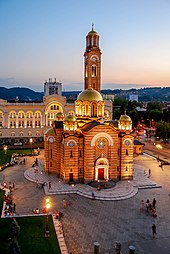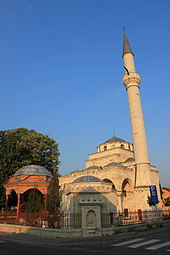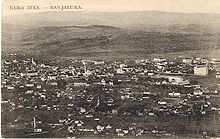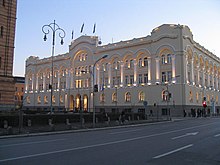Banja Luka
|
Banja Luka Бања Лука |
||
|
|
||
| Basic data | ||
|---|---|---|
| State : | Bosnia and Herzegovina | |
| Entity : | Republika Srpska | |
| Municipality : | Banja Luka | |
| Coordinates : | 44 ° 46 ' N , 17 ° 11' E | |
| Height : | 163 m. i. J. | |
| Area : | 1,239 km² | |
| Residents : | 184,257 (2018) | |
| Population density : | 149 inhabitants per km² | |
| Telephone code : | +387 (0) 51 | |
| Postal code : | 78,000 | |
| Structure and administration (as of 2016) | ||
| Mayor : | Igor Radojičić ( SNSD ) | |
| Website : | ||
Banja Luka ( Serbian - Cyrillic Бања Лука , German outdated Weina Luka , Luka ) is a city in the north of Bosnia and Herzegovina and the seat of government of the Republika Srpska . The city is the seat of a Serbian Orthodox and Roman Catholic diocese and the University of Banja Luka . With around 185,000 inhabitants (2013 census), Banja Luka is the most populous municipality in Bosnia and Herzegovina and its second largest city.
geography
The city is located in the northwest of the country of Bosnia and Herzegovina . Banja Luka lies on both banks of the Vrbas , which flows from a gorge landscape to the south into the Pannonian lowlands to the Save . The Vrbanja joins here from the right. The city is surrounded by low mountain ranges. The region south of the city is very mountainous, there is the Vrbas Gorge. North of the city the landscape is rather flat.
Banja Luka is known for its avenues and is therefore called the “Green City”. It is popularly said that in Banja Luka there are twice as many trees as people.
In the Trapisti district there is a thermal bath , a state health resort hospital and a military hospital.
Districts
The following districts belong to the core city:
- Centar
- Borik
- Obilićevo or Mejdan
- Starčevica
- Kočićev Vijenac or Hiseta
- Pobrdje
- Louse
- Nova Varoš
- Rosulje
- Paprikovac
- Petričevac
In the suburbs are the districts:
- in the southeast : Rebrovac , Vrbanja , Debeljaci
- in the south : Srpske Toplice (Šeher and Gornji Šeher), Novoselija , Banjbrdo
- in the east : Medeno Polje , Česma , Kumsale , Madjir , Trapisti
- in the north : Lazarevo (Budžak), Delibaševo (Lazarevo), Drakulić , Derviši , Novakovići , Srpski Milanovac (Tunjice), Vujinovići , Zalužani , Priječani
A semi-urban district (suburb) outside the municipality of Banja Luka is Trn (municipality of Laktaši).
Larger villages and settlements in the municipality of Banja Luka outside the core city are:
- in the south : Kola , Jagare , Karanovac , Rekavice , Bočac , Agino Selo , Krupa na Vrbasu
- in the southeast : Zeleni Vir
- to the west : Motike , Bistrica , Stratinska
- in the northwest : Šargovac , Dragočaj , Mišin Han , Potkozarje
Climate table
| Banja Luka | ||||||||||||||||||||||||||||||||||||||||||||||||
|---|---|---|---|---|---|---|---|---|---|---|---|---|---|---|---|---|---|---|---|---|---|---|---|---|---|---|---|---|---|---|---|---|---|---|---|---|---|---|---|---|---|---|---|---|---|---|---|---|
| Climate diagram | ||||||||||||||||||||||||||||||||||||||||||||||||
| ||||||||||||||||||||||||||||||||||||||||||||||||
|
Average monthly temperatures and rainfall for Banja Luka
Source: wetterkontor.de
|
|||||||||||||||||||||||||||||||||||||||||||||||||||||||||||||||||||||||||||||||||||||||||||||||||||||||||||||||||||||||||||||||||||||||||||||||||||||||||||||||||||||
history

The original settlement quickly gained importance with the Roman trade route from Salona ( Split ) to Servitium ( Gradiška ). The Romans had fortified the settlement with city walls for the first time in order to secure the trade route and to be able to use the healing springs they discovered. After the fall of the Roman Empire, Slavs took over the city.
Banja Luka was first mentioned by name in 1494 by the Hungarian King Vladislav . The origin of the name is unclear, possibly it is derived from the words Ban and Luka . Ban / Banj ( ruler ) was a sovereign title that was replaced by "Kralj" ( king ) in Bosnia in the 13th century , "Luka" means port or "place of rest", so the name can best be described as "royal port" translate. In Hungarian , "bánya" stands for mine. Banja (Cyrillic бања) is the Slavic term for a bathhouse.
After the conquest by the Ottomans in 1528, the city was integrated into the Paschalik Bosnia . During this heyday of the city, a number of bridges, mills and 40 mosques were built, most of which, including the now rebuilt Ferhadija Mosque and the Arnaudija Mosque , were deliberately destroyed by the Serbian armed forces during the Bosnian War of 1992–1995. During the centuries of the Ottoman rule, Banja Luka was destroyed several times by Turkish-Austrian wars, but also by earthquakes . Again and again the population was decimated by the plague .
The Austrians under Margrave Ludwig Wilhelm von Baden-Baden captured Banja Luka for a short time on September 4, 1688. In contrast, the imperial general Joseph Friedrich von Sachsen-Hildburghausen , having besieged the city since July 23, 1737, suffered a defeat and lifted the siege on August 4th.

In the 19th century, Banja Luka was annexed by Austria-Hungary , who modernized the city by building factories and providing transport links to Vienna and other cities of the monarchy. The synagogue was built in 1884.
The city flourished again in the Kingdom of Yugoslavia , to which it belonged after 1918. From 1929 to 1941, Banja Luka was the capital of the Vrbas Banschaft , which included the western part of what is now Bosnia-Herzegovina. During this time, important buildings were erected such as the town hall (formerly the seat of the Banschaft), the city theater and the Orthodox Church of the Redeemer.
On March 25, 1941, Prince Regent Paul of Yugoslavia signed the Tripartite Pact , which triggered demonstrations in many Yugoslav cities, including Banja Luka, and in response to the German attack on April 6, 1941 on the Kingdom of Yugoslavia. Banja Luka was badly destroyed by the Air Force on April 9, 1941. After the capitulation of Yugoslavia, Banja Luka was added to the Ustaše state , which began persecuting Serbs , Jews and Roma . The largest massacre in Banja Luka and one of the largest on the territory of the Ustasha state took place on February 7, 1942, the so-called massacre of Banja Luka , as units of the Ustasha under the leadership of Josip Mislov and the former Franciscan Miroslav Filipović around 2,300 Serbs , mostly women and old men, murdered with bare weapons. On April 22, 1945, Banja Luka was captured by the Yugoslav People's Liberation Army ("Partisans").
On October 26 and 27, 1969, the last major earthquake so far destroyed large parts of the city and made many residents homeless.
Although the battle line did not go through Banja Luka, many Roman Catholic and Muslim places of worship were blown up by the Bosnian Serbs during the Bosnian War . After the end of the war, the seat of government of the Republika Srpska was moved from Pale to Banja Luka on January 31, 1998 . The city was not badly affected by the war, but the composition of the population has changed significantly. On the one hand, most of the non-Serbian residents have fled or been expelled; on the other hand, the city has taken in many Serbian refugees from other parts of Bosnia. Today every third inhabitant is a refugee or displaced person .
population
The population of the area around Banja Luka was ethnically mixed before the Bosnian War (1992 to 1995). Today the region is almost exclusively inhabited by ethnic Serbs because, on the one hand, many Croatians and Bosniaks were expelled from the city or fled during the civil war and, on the other hand, many Serb refugees from other parts of the country settled and occupied the houses and apartments of the refugee Croats and Bosniaks. Only minorities of Croats and Bosniaks still live in the city and its surroundings.
The 1991 census showed the following composition for the municipality:
- Serbs - 106,826 (54.59%)
- Croatians - 29,026 (14.83%)
- Muslims in the national sense - 28,558 (14.59%)
- Yugoslavs - 23,656 (12.09%)
- other - 7,626 (3.89%)
The 2013 census resulted in the following figures:
- Serbs - 165,750 (89.57%)
- Bosniaks - 7,681 (4.15%)
- Croatians - 5,104 (2.76%)
- other - 6507 (3.52%)
The Opština (municipality) Banja Luka extends far beyond the urban districts and includes villages and settlements within a radius of 20 kilometers.
In addition, the urban part of the city is located on the northeastern outskirts of Laktaši and Čelinac . Therefore, there are parts of the city that are beyond the municipal boundaries. The best example is Trn , the southernmost part of the municipality of Laktasi, which has more inhabitants than Laktaši center and has practically merged with the city of Banja Luka, but not with Laktaši center. For these reasons, the population of the municipality does not correspond to that of the city proper.
- Core city (the narrower or central parts of the city): 165,000 inhabitants (2004 estimate)
- More urban urban area including gates: 195,000 (2007 estimate)
- Large municipality of Banja Luka (without Trn): 224,000 (2007)
coat of arms
In February 2013, the Constitutional Court of the Republika Srpska declared the arms of Banja Luka and Nevesinje to be non-constitutional due to the reference to an ethnic group made by the Serbian cross shown in both .
On June 5, 2013, Mayor Slobodan Gavranović presented a new draft that is currently still being discussed publicly.
economy
The city and region of Banja Luka have developed into one of the economically strongest regions in Bosnia-Herzegovina in recent years. On the one hand, the city with its narrower region benefits from the fact that it is one of the few areas that was spared from the war (while other cities and regions are busy with reconstruction), on the other hand, the north-west of Bosnia was also considered economically strong before the war. In addition, the centralistic stance of the Republika Srpska is held responsible for the fact that its capital (Banja Luka) is booming and that other parts of the Republika Srpska (especially in the eastern part, especially around Foča ) are barely developing economically. In addition, liberal political forces in the western part of the Republika Srpska have gained more and more influence in recent years, while the eastern part is more or less a stronghold of radicals and nationalists, which is another reason for the different development of the regions in the Republika Srpska.
In July 2008 Transparency International closed its representation in Banja Luka out of concern for the safety of its employees on site. At the beginning of 2008, the then Prime Minister of the Republika Srpska, Milorad Dodik , had been criticized by the organization for an agreement between his government and Strabag on the construction of highways, as the details of this process, which had to be advertised, had been kept secret. Furthermore, the privatization of the Banja Luka Stock Exchange was criticized as illegal. Thereupon Dodik accused Transparency International that their employees had tried to extort money from local companies and had assured them in return that they would not appear on Transparency International's "black lists" for doing so. However, the allegations could not be confirmed.
traffic
The Gradiška-Banja Luka motorway and the Doboj-Banja Luka motorway , which so far (as of September 2017) have been opened to traffic to Drugovići near Laktaši, run through the urban area of Banja Luka . Large parts of the Gradiška – Banja Luka motorway have been open to traffic since 2011. An expansion via Gradiška to Croatia with a connection to the Autocesta A3 ( Zagreb - Belgrade ) is planned.
The railway line Banja Luka – Doboj and Banja Luka – Sunja , on the express trains to Sarajevo, Bihać and Zagreb run from the city. Banja Luka Central Railway Station was renovated in 2000. Banja Luka International Airport is located 28 kilometers north of the city in the municipality of Laktaši and can be reached in 30 minutes by car. This was formerly a helicopter military airfield of the Yugoslav army and has been reconstructed for several years. Another runway and two terminals are planned. Scheduled flights connect Banja Luka several times a week with Berlin , Brussels , Stockholm , Memmingen , Frankfurt and Belgrade (as of February 2020). From April 2020, Lauda will fly twice a week from Vienna to Banja Luka.
Public transport in Banja Luka consists entirely of buses. A trolleybus network is being planned, however.

media
Banja Luka is the seat of the public radio and television station of the Republika Srpska Radio-Televizija Republike Srpske as well as other private television and radio stations, including six regional private stations, the best known of which is the station Alternativna Televizija ATV .
Sports
FK Borac Banja Luka is the city's most famous football club and is represented in the Prva Liga RS . In the 1987/88 season, Borac became the first second division to win the Yugoslav Cup. In the final, record champions Red Star Belgrade were defeated 1-0. In 1992 Borac Banja Luka won the last edition of the traditional Mitropa Cup . In the 2010/11 season, they made it into the UEFA Champions League for the first time .
RK Borac Banja Luka is a handball club founded in 1950. RK Borac is multiple national champion and won the European Champion 's Cup in 1975/76 and the EHF Cup in 1990/91 .
Attractions

The Ferhadija Mosque , built by the Ottomans in 1579, was blown up by Serbian nationalists during the Bosnian War on the morning of May 7, 1993 and rebuilt by 2014.
With the Serbian Orthodox Cathedral of Christ the Savior ( Saborni Hram Hrista Spasitelja ), the city has the only church building in Southeastern Europe with golden domes. The church was damaged in World War II and finally destroyed by the Ustaše, but was rebuilt true to the original between 1995 and 2005.
There are two sacred buildings in Lazarevo, namely the Roman Catholic Trappist monastery Marija-Zvijezda , at the beginning of the 20th century the only Trappist monastery in Southeast Europe and with 219 monks at that time the largest Trappist abbey in the world. The Serbian Orthodox Church is dedicated to the Holy Great Martyr Prince Lazar (Lazarica of Banja Luka).
The partisan monument Banj Brdo or Šehitluci by the sculptor Antun Augustinčić located above the town is also known . Also worth seeing is the Kastel , a fortress that was built by the Romans and which was reduced in size for its purposes during the membership of the Ottoman Empire.
In the northern part of the city in Zaluzani is the only race track in Bosnia-Herzegovina. Races are often held, but they are of little importance. We are currently looking for investors to upgrade the racetrack and its infrastructure to international standards.
Personalities
- Petar Kočić (1877-1916), writer
- Vlado Milošević (1901–1990), composer
- Guido Cardinal del Mestri (1911–1993), Vatican diplomat
- Abas Arslanagić (* 1944), handball player and coach
- Franjo Komarica (* 1946), Roman Catholic bishop
- Marijan Beneš (1951–2018), professional boxer with BK Slavija in Banja Luka
- Emir Krajišnik (* 1954), painter, sculptor and video artist
- Velimir Petković (* 1956), handball coach
- Željko Buvač (* 1961), football coach
- Saša Lošić (* 1965), singer
- Indira Radić (* 1966), singer
- Aleksandar Knežević (* 1968), handball player and coach
- Dejan Terzic (* 1970), jazz musician
- Malik Beširević (* 1972), handball player
- Božidar Jović (* 1972), handball player
- Draženko Ninić (* 1973), kickboxing world champion
- Dalibor Anušić (* 1976), handball player
- Mladen Bojinović (* 1977), handball player
- Ivan Ljubičić (* 1979), tennis player
- Darko Maletić (* 1980), football player
- Vladan Grujić (* 1981), football player
- Zlatan Muslimović (* 1981), football player
- Adnan Mravac (* 1982), football player
- Danijel Majkić (* 1987), football player
- Marija Šestić (* 1987), singer
- Neven Subotić (* 1988), football player
- Mario Grgić (* 1991), football player
Twin cities
Banja Luka lists the following twelve twin cities :
| city | country | since |
|---|---|---|
| Bari |
|
2007 |
| Belgrade |
|
2003 |
| Bitonto |
|
2008 |
| Campobasso |
|
2010 |
| Kaiserslautern |
|
2003 |
|
|
|
2006 |
| Lviv (Lviv) |
|
2005 |
| Modi'in |
|
2010 |
| Moscow |
|
2003 |
| Novi Sad |
|
2006 |
| Patras |
|
2003 |
| Sremska Mitrovica |
|
Web links
Individual evidence
- ↑ http://rzs.rs.ba/front/article/3630/ Updated population figures for 2018 from the Institute for Statistics of the Republika Srpska. Retrieved June 9, 2019.
- ↑ Rezultati popisa 2013 on popis.gov.ba (PDF file, 11.9 MB); accessed on June 13, 2017.
- ↑ Vojnogeografski institute, Ed. (1955): Banja Luka (List map 1: 100,000, Izohipses near 20 m). Vojnogeografski institut, Beograd.
- ↑ Spahić M. et al. (2000): Bosna i Hercegovina (1: 250,000). Izdavačko preduzeće "Sejtarija", Sarajevo.
- ↑ kartabih
- ↑ Mučibabić B., Ed. (1998): Geografski atlas Bosne i Hercegovine. Geodetski zavod BiH, Sarajevo.
- ↑ Agencija za statistiku Bosne i Hercegovine: Popis stanovništva, domaćinstava i stanova u Bosni i Hercegovini, 2013. Rezultati popisa. (pdf, 19.7 MB) Sarajevo, June 2016; P.56
- ↑ Neustavni grbovi Banjaluke i Nevesinja . Serbian. Online at www.nezavisne.com February 20, 2013, accessed February 21, 2013.
- ↑ Gavranović-imamo novi grb . Serbian. Online at www.nezavisne.com June 5, 2013, accessed June 6, 2013
- ↑ (VIDEO) Banjalučanima se ne sviđa novi grb ( Memento of the original from June 9, 2013 in the Internet Archive ) Info: The archive link was inserted automatically and has not yet been checked. Please check the original and archive link according to the instructions and then remove this notice. . Serbian. Video - New coat of arms is shown. Online at www.banjalukalive.com June 6, 2013, accessed June 6, 2013.
- ↑ Oliver Grimm: Anti-Corruption Association driven out of Bosnia . In: Die Presse from July 19, 2008
- ↑ https://www.klix.ba/vijesti/bih/u-nedjelju-otvaranje-nove-dionice-autoputa-banja-luka-doboj/170927033
- ↑ Homepage of the association .
- ↑ ASBL >> Partner Cities. (No longer available online.) Archived from the original on April 12, 2017 ; Retrieved April 12, 2017 . Info: The archive link was inserted automatically and has not yet been checked. Please check the original and archive link according to the instructions and then remove this notice.










